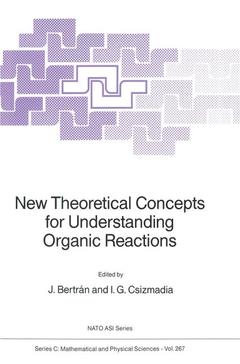New Theoretical Concepts for Understanding Organic Reactions, 1989 Nato Science Series C: Series, Vol. 267
Langue : Anglais
Coordonnateurs : Bertrán Juan, Csizmadia Imre G.

People who attended the NATO Advanced Study Institute (ASI) entitled NEW THEORETICAL CONCEPTS FOR UNDERSTANDING ORGANIC REAC TIONS held at Sant Feliu de Gufxols on the Costa Brava of Spain had a unique experience. They have seen the evolution of the field from qualitative arguments through the generation of Potential Energy Surfaces (PES) to the use of PES in molecular dynamics. The excellent lectures that were dedicated to the various aspects of Potential Energy Surfaces clearly revealed a colossal amount of ma terial that represents our current understanding of the overall problem. It is our hope that the present volume will recreate the excitement in the readers that we all experienced during the meeting in Spain. One can say, without too much exaggeration, that chemistry has become and exercise on potential energy surfaces (PES). Structural (position of the energy minima), spectroscopic (vicinity around the minima), and reactivity (reaction path along the surface) properties may be determined from the analysis of PES. New theoretical tools, together with recent developments in computer technology and programming, have allowed to obtain a better knowledge of these surfaces, and to extract further chemical information from them, so new horizons have been added to Theoretical Organic Chemistry.
Multidimensional theoretical stereochemistry and conformational potential energy surface topology.- Some practical suggestions for optimizing geometries and locating transition states.- Reaction topology and quantum chemical molecular design on potential energy surfaces.- Topology of molecular shape and chirality.- Adiabatic and diabatic surfaces in the treatment of chemical reactivity. I. Theory.- Adiabatic and diabatic surfaces in the treatment of chemical reactivity. II. An illustrative application to the Diels Alder reaction.- A qualitative valence bond model for organic reactions.- Solvent effects on potential energy surfaces and chemical kinetics.- Modifications of potential energy surfaces by solvation and catalysis.- Computational tests of potential energy surfaces from dynamical properties.- Dynamical formulation of transition state theory: variational transition states and semiclassical tunneling.- Theoretical models for reaction dynamics in polyatomic molecular systems.- Practical applications of new theoretical concepts in organic chemistry.
Date de parution : 10-2011
Ouvrage de 392 p.
15.5x23.5 cm
Thème de New Theoretical Concepts for Understanding Organic Reactions :
© 2024 LAVOISIER S.A.S.



